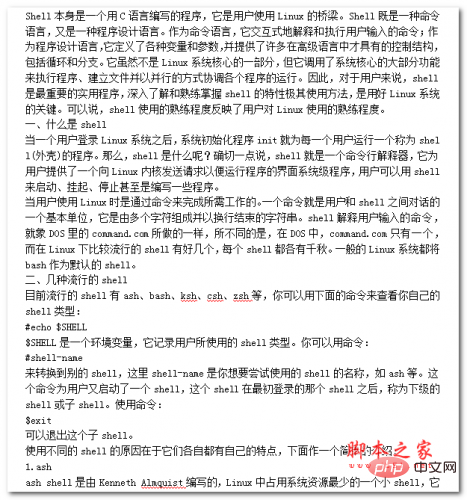概述
考虑这样一个问题,有hello.py脚本,输出”hello, world!”;有TestInput.py脚本,等待用户输入,然后打印用户输入的数据。那么,怎么样把hello.py输出内容发送给TestInput.py,最后TestInput.py打印接收到的”hello, world!”。下面我来逐步讲解一下shell的交互方式。
hello.py代码如下:
#!/usr/bin/python print "hello, world!"
TestInput.py代码如下:
#!/usr/bin/python
str = raw_input()
print("input string is: %s" % str)
1.os.system(cmd)
这种方式只是执行shell命令,返回一个返回码(0表示执行成功,否则表示失败)
立即学习“Python免费学习笔记(深入)”;
retcode = os.system("python hello.py")
print("retcode is: %s" % retcode);
输出:
hello, world! retcode is: 0
2.os.popen(cmd)
执行命令并返回该执行命令程序的输入流或输出流.该命令只能操作单向流,与shell命令单向交互,不能双向交互.
返回程序输出流,用fouput变量连接到输出流
fouput = os.popen("python hello.py")
result = fouput.readlines()
print("result is: %s" % result);
输出:
result is: ['hello, world!\n']
返回输入流,用finput变量连接到输出流

Shell本身是一个用C语言编写的程序,它是用户使用Linux的桥梁。Shell既是一种命令语言,又是一种程序设计语言。作为命令语言,它交互式地解释和执行用户输入的命令;作为程序设计语言,它定义了各种变量和参数,并提供了许多在高级语言中才具有的控制结构,包括循环和分支。它虽然不是Linux系统核心的一部分,但它调用了系统核心的大部分功能来执行程序、建立文件并以并行的方式协调各个程序的运行。因此,对于用户来说,shell是最重要的实用程序,深入了解和熟练掌握shell的特性极其使用方法,是用好Linux系统
 24
24

finput = os.popen("python TestInput.py", "w")
finput.write("how are you\n")
输出:
input string is: how are you
3.利用subprocess模块
subprocess.call()
类似os.system(),注意这里的”shell=True”表示用shell执行命令,而不是用默认的os.execvp()执行.
f = call("python hello.py", shell=True)
print f
输出:
hello, world! 0
subprocess.Popen()
利用Popen可以是实现双向流的通信,可以将一个程序的输出流发送到另外一个程序的输入流.
Popen()是Popen类的构造函数,communicate()返回元组(stdoutdata, stderrdata).
p1 = Popen("python hello.py", stdin = None, stdout = PIPE, shell=True)
p2 = Popen("python TestInput.py", stdin = p1.stdout, stdout = PIPE, shell=True)
print p2.communicate()[0]
#other way
#print p2.stdout.readlines()
输出:
input string is: hello, world!
整合代码如下:
#!/usr/bin/python
import os
from subprocess import Popen, PIPE, call
retcode = os.system("python hello.py")
print("retcode is: %s" % retcode);
fouput = os.popen("python hello.py")
result = fouput.readlines()
print("result is: %s" % result);
finput = os.popen("python TestInput.py", "w")
finput.write("how are you\n")
f = call("python hello.py", shell=True)
print f
p1 = Popen("python hello.py", stdin = None, stdout = PIPE, shell=True)
p2 = Popen("python TestInput.py", stdin = p1.stdout, stdout = PIPE, shell=True)
print p2.communicate()[0]
#other way
#print p2.stdout.readlines()

python怎么学习?python怎么入门?python在哪学?python怎么学才快?不用担心,这里为大家提供了python速学教程(入门到精通),有需要的小伙伴保存下载就能学习啦!

Copyright 2014-2025 https://www.php.cn/ All Rights Reserved | php.cn | 湘ICP备2023035733号